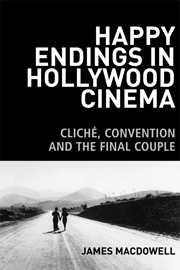4 - Happy endings and ideology
Published online by Cambridge University Press: 05 October 2013
Summary
‘Girls are taught a lot of stuff growing up,’ says Gigi, the narrator of He's Just Not That Into You: ‘If a guy punches you he likes you. Never trim your own bangs. And some day you will meet a wonderful guy and get your very own happy ending’. A seven-year-old Mary (Cortney Shounia) in The Wedding Planner tells her Barbie doll ‘You'll live happily ever after,’ as she marries her off to a Ken. In French Kiss Kate (Meg Ryan) tearfully says of her ex-fiancé: ‘I'm going to get him back, and make him love me, and we are going to live happily ever after!’
As I have suggested, most spoken references to ‘happy endings’ or ‘happily-ever-afters’ uttered in Hollywood cinema invoke these concepts only to qualify them in some way. The examples above are no exception: Gigi goes on to explain that ‘sometimes we're so focused on finding our happy ending that we don't learn how to […] tell the ones who'll stay from the ones who'll leave’; The Wedding Planner dissolves from a close-up of Barbie's face to a real-life bride who is apparently petrified by the prospect of marriage (‘I'm marrying the wrong guy!’ she wails); Kate is at this moment talking about her film's ‘unsuitable’ partner. Yet – as we saw in the last chapter – Hollywood films do nonetheless often invoke these concepts, and not only in order to accuse them of unrealism, but frequently also in a manner suggesting that they are highly relevant to how characters live their lives.
- Type
- Chapter
- Information
- Happy Endings in Hollywood CinemaCliche, Convention and the Final Couple, pp. 133 - 190Publisher: Edinburgh University PressPrint publication year: 2013



